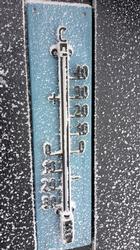
Cold temperature impacts Forklifts and Batteries
Does temperature affect forklift safety, mechanical issues or battery lifespan? Without the right precautions in place, it can.
Whether it’s working in cold storage areas in your facility or winter weather, some forklifts show a 25-50% decrease in cycle times during cold weather. Condensation also plays a role in reducing safety and causing mechanical issues. By following maintenance precautions and battery monitoring, you can avoid cold temperature pitfalls.
Chilly challenges for forklifts
Even forklifts built for cold storage are challenged by freezing temperatures. Very low temperatures affect mechanical health and condensation can accumulate as they move from cold storage to warmer areas in the facility. When the truck re-enters the cold-room, this condensation quickly turns to ice.
Even if the temperature does not vary throughout the warehouse, forklift operations can become more challenging during the winter thanks to harsher temperatures, ice, and snow. It all depends on the enterprise, of course, and how much the fleet is exposed to changing conditions.
Here are a few ways cold temperatures may impact your fleet:
- Cold temperatures affect a battery’s electrolyte, causing it to thicken and struggle to achieve the chemical reaction needed to power the forklift. As a result, battery life may be shorter.
- Freezing temperatures thicken the forklift’s oil — sometimes to the thickness of honey. This lowers the amps and causes all hydraulic-powered functions to slow down. Oil with lower viscosity performs better in cold temperatures.
- Cold temperatures can require more fuel to operate gas and diesel forklifts.
- For forklifts operating in both warm and cold areas, extreme changes in temperature can cause condensation to form. That leads to inefficient operations and additional downtime for the forklift.
- Snow, ice or freezing rain may make outdoor surfaces and loading bays slippery, increasing the risk of heavy forklifts sliding down icy embankments. Lift truck operators must be trained in winter driving conditions.
Cold weather precautions
There are a few things you can do to protect your fleet and operators from cold temperature challenges. Here are five cold weather precautions:
- Make sure the batteries are holding a charge properly. Battery-monitoring technology can show a battery’s discharge, temperature, voltage, and amperage — providing real-time alerts and warnings while in use.
- Optimize forklift routes and limit the number of times the truck needs to go from room temperature to a freezing environment. This reduces the chances for condensation to form and prevents potential mechanical damage caused by frozen condensation.
- Make sure operators complete safety checks by using a telematics system that locks the vehicle if the checklist is not successfully completed.
- Make sure the water-to-coolant ratio is correct to prevent radiator issues or, worse, cracked blocks.
- Monitor operator behavior, winter driving skills, and adherence to speed limits. Speed limits should be enforced in any location affected by the weather or icing.
Cold temperatures can impact the health of your forklifts — and the batteries that power them — if they aren’t being properly maintained. By deploying an advanced telematics system, you can ensure you’re taking precautions that support safety and avoids costly vehicle downtime.
Topics: Forklift safety, workplace accidents, cold storage, maintenance tracking, telematic fleet management,battery charging, warehousing









